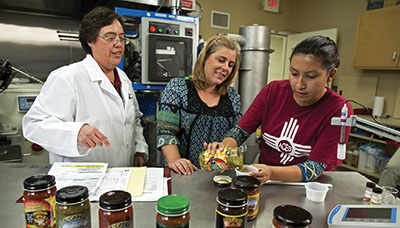Guide E-510C
Revised by Nancy Flores and Jay Lillywhite
College of Agricultural, Consumer and Environmental Sciences, New Mexico State University
Authors: Respectively, Associate Professor/Extension Food Technology Specialist, Department of Extension Family and Consumer Sciences; and Professor/Department Head, Department of Agricultural Economics and Agricultural Business, New Mexico State University. (Print Friendly PDF)
Introduction
Many people dream of owning their own food business and marketing a family recipe as a small family enterprise. There are always opportunities for new food products in today’s marketplace. This publication, the third in a series on starting a food business in New Mexico, outlines the necessary steps to manage the permitting process through regulatory agencies and food safety aspects of a food business in New Mexico. For more information on starting a food business in New Mexico, visit these resources:
- Guide E-510A: Starting a Food Business in New Mexico: Food Business Management: https://pubs.nmsu.edu/_e/E510A/index.html
- Guide E-510B: Starting a Food Business in New Mexico: Food Processing: https://pubs.nmsu.edu/_e/E510B/index.html
Permits And Regulations
Permits and regulations depend upon the product and where it is produced or made. For example, a city health department inspects food businesses within the city limits, while a county health department may inspect a food business within the county limits. Table 1 shows examples of commodities and regulatory agencies with their required permits.
It is important to establish a good working relationship with state and federal regulatory agents and inspectors early in business and product development. The New Mexico Environment Department (NMED) Food Safety Bureau has an environmentalist in every county who is responsible for inspecting restaurants and food-processing facilities. These inspectors have many years of experience and can offer assistance in meeting building codes and addressing issues with food safety and process control. If there are issues with your product or commodity, such as a recall, the regulators can be helpful in bringing things under control quickly. A list of NMED district field offices is available at https://www.env.nm.gov/contact-us/.
|
Table 1. Commodity Food Products and Regulating Agencies |
|||
|
Commodity |
Regulating agency* |
Permit issued? |
Comments |
|
All food-processing facilities |
FDA |
Registration |
Bioterrorism Act: http://bit.ly/2vgDrLL Required for all domestic and foreign facilities. |
|
Food importers |
FDA |
Registration, notification of import |
Registration: http://bit.ly/2vYLKPi Information: http://bit.ly/2vZ9yCt |
|
Acidified (e.g., salsa), low-acid (e.g., green beans, meat) |
FDA |
Yes |
Attend Better Process Control School; listing: https://consumerbrandsassociation.org/about-us/programs-initiatives/better-process-control-school/ Instructions for electronic submission of FDA Form 2541: |
|
USDA |
Yes |
||
|
Low-acid (e.g., green beans) |
FDA |
Yes |
|
|
Beef jerky |
USDA, NMED |
Yes |
Product distribution determines regulating agency. |
|
Baked goods |
NMED |
Yes |
File application. May need to refrigerate depending on water activity level. |
|
Raw commodity, consumed raw; food producer (fresh fruit, produce, honey, dried chile, unprocessed nuts) |
NMED |
No |
***Follow Good Manufacturing Practices (GMP): http://bit.ly/2woUMpL Weights and measures: |
|
FDA |
Registration |
||
|
Fresh/frozen meat |
NMDA, USDA |
Yes |
File application; inspection during processing. |
|
Fresh/frozen seafood |
FDA |
Yes |
File application; Hazard Analysis Critical Control Point (HACCP): http://bit.ly/2iqlMiV |
|
Catfish |
USDA |
Yes |
https://www.fsis.usda.gov/inspection/inspection-programs/inspection-siluriformes |
|
Water/ice plant |
NMED |
Yes |
Scroll down to “Drinking Water Bureau”: |
|
Dairy, milk, cheese |
NMDA |
Yes |
Information: http://bit.ly/2is1t4B |
|
Eggs |
NMED |
Yes |
Information: http://bit.ly/2vgmgdn |
|
Organic processed foods |
NMDA, NMED |
Yes |
Three-year certification process; file application. https://www.nmda.nmsu.edu/nmda-homepage/divisions/marketing/organic-program/ |
|
Homemade food |
NMED |
No |
Information: https://www-archive.env.nm.gov/foodprogram/homemadefood/ |
|
CBD/hemp food products |
NMED |
Yes |
Information: |
|
Alcohol-containing food or alcoholic beverages |
New Mexico Alcoholic Beverage Control Division (http://rld.state.nm.us/abc/) |
Yes |
Application information: https://www.rld.nm.gov/alcohol-beverage-control/applications-forms-laws-rules-and-required-posters/ |
|
* Regulating agencies: FDA = U.S. Food and Drug Administration, USDA = U.S. Department of Agriculture, NMED = New Mexico Environment Department, NMDA = New Mexico Department of Agriculture ** PA = Process Authority, FDA form 2541 is “Food Canning Establishment Registration,” FDA form 2541a is “Food Process Filling for All Methods Except Low-Acid Aseptic” *** All food-processing facilities must follow GMPs, weights and measures, and labeling regulations. |
|||
The New Mexico Homemade Food Act (HFA)
The New Mexico Homemade Food Act became effective July 1, 2021, and allows individuals to make certain low-risk foods in their private farm, ranch, or residence without a food permit from the NMED. These homemade food products can be marketed or sold only directly to consumers. Grocery stores or similar facilities may not purchase or resell prepackaged homemade foods. Additionally, NMED-permitted food facilities may not use homemade foods as ingredients in their food item. Homemade items may not be sold to a restaurant, a wholesaler or distributor, or outside the state of New Mexico. The HFA is enforced by the NMED Food Safety Bureau via complaints concerning improper labeling or foodborne illness. Homemade food processors must take food handler certification training that is offered online (https://tap.nmsu.edu/index.html), which is valid for three years.
Packaged product must have a label with the words “This product is home produced and is exempt from state licensing and inspection. This product may contain allergens,” as well as the following information:
- The name, street address, city, state, zip code, email address, and phone number of the producer.
- An accurate statement of the net amount of food in the package in either weight measure, volume measure (listed in both “English” and metric units), or numerical count.
- The common or usual name of the food contained in the package.
- Ingredients of the food, including sub-ingredients, listed by their common names, in order of their predominance by weight.
Non-Time/Temperature Control For Safety
Certain foods will not support the growth of pathogenic microorganisms at room temperature, will have a pH of 4.6 or less, and will have a water activity of 0.85 or less. Examples of these products are traditional baked goods (no cream filling or sour cream frosting), hard candy (non-chocolate), nuts, honey, dried beans, dried chile, herbs, and traditional high-sugar jams and jelly products. Other regulations control acidified and low-acid foods as well as jerky products, which are not allowed to be produced in a home kitchen. A process authority (who are available at New Mexico State University and other state universities) can evaluate products that are not clearly classified by this definition.
More information related to these regulations can be found at https://www.env.nm.gov/foodprogram/retail-food-application/, or by contacting the NMED Food Program Manager:
Johnathan Gerhardt
121 Tijeras NE, Ste. 1000
Albuquerque, NM 87102
Email: food.program@state.nm.us
Food Safety, Food Defense, And Biosecurity
There are various systems that are mandated by state and federal law to improve food safety and security. All of these systems require careful consideration of the process, facility, personnel, and protection of the final product. All personnel must be trained on and understand the principles of the food safety plans and must follow these procedures. Additionally, these systems require complete documentation along with a recall procedure in case of contamination, mislabeling, or misuse of the product. One or more of the following food safety systems may apply to your food product.
Hazard Analysis and Critical Control Point (HACCP, pronounced hassip). This is a preventive system rather than the typical reactive system (such as sampling and inspection of food products after manufacturing). Many HACCP principles are already in place in the FDA-regulated low-acid canned food industry and the seafood and juice industries. More information can be found at http://www.fda.gov/Food/GuidanceRegulation/HACCP/.
Good Manufacturing Practices (GMPs). GMPs are operational sanitation procedures for personnel, facilities, and grounds and proper maintenance of equipment. These practices are basic to any food-processing operation and are required by law (21 C.F.R. § 117). More information can be found at https://www.fda.gov/food/guidance-regulation-food-and-dietary-supplements/current-good-manufacturing-practices-cgmps-food-and-dietary-supplements.
Good Agricultural Practices (GAPs). The goal of the GAP project is to reduce microbial risks in fruits and vegetables by providing educational material for a food safety plan to food producers and educational professionals associated with agriculture. This is not a mandated program; however, brokers and distributors are asking food producers and processors to pass third-party inspections based on GAP requirements. Information can be found at https://www.ams.usda.gov/services/auditing/gap-ghp.
Public Health Security and Bioterrorism Preparedness and Response Act. The events of September 11, 2001, reinforced the need to enhance the security of the United States. The Public Health Security and Bioterrorism Preparedness and Response Act of 2002 (the Bioterrorism Act) was signed into law on June 12, 2002 (the entire document can be found at http://www.gpo.gov/fdsys/pkg/PLAW-107publ188/html/PLAW-107publ188.html). Section 305 of the Bioterrorism Act added section 415 to the Federal Food, Drug, and Cosmetic Act to include Registration, Administrative Detention, Record Keeping, and Prior Notice to provide FDA with information on the origin and distribution of food and feed products and thereby aid in the detection of and quick response to actual or potential threats to the U.S. food supply.
Registration of food-processing facilities. The Bioterrorism Act requires domestic and foreign facilities to register with FDA as of December 12, 2003, if they manufacture, process, pack, or hold food for human or animal consumption in the United States. The purpose of registration is to provide FDA with sufficient and reliable information about food and feed facilities. Registration information will also help FDA to notify facilities that may be affected by actual or potential threats. Facilities can register online at http://www.fda.gov/Food/GuidanceRegulation/FoodFacilityRegistration/default.htm.
A copy of this registration form can be requested by phone at 800-216-7331 or 301-575-0156. Complete the form legibly and mail it to the address below, or fax it to 301-210-0247. This form can also be obtained by writing to:
U.S. Food and Drug Administration
HFS-681
5600 Fishers Lane
Rockville, MD 20857
Food Defense Plan. A Food Defense Plan is a security plan that will reduce the likelihood of someone intentionally contaminating or damaging your food product in order to kill or hurt people, disrupt the food supply and damage the local economy, or ruin your business. This plan includes having security measures for the facility, incoming and outgoing shipments, chemical storage, mail, and employees, and limiting access to visitors. The plan may also include policies for record storage and disposal and information kept on computers and online. Additionally, an emergency response plan should be included in case of an incident, with contact information for local law enforcement and medical response teams. A template plan can be downloaded at http://www.fda.gov/Food/FoodDefense/ToolsEducationalMaterials/ucm349888.htm.
Food Safety Modernization Act (FSMA)
The Food Safety Modernization Act amended section 415 of the Federal Food, Drug, and Cosmetics Act (FD&C Act; 21 U.S.C. § 350d), which requires domestic and foreign facilities that manufacture, process, pack, or hold food for human or animal consumption in the U.S. to comply with specific preventive measures to ensure food safety. Comprehensive, science-based preventive controls will be required of all food producers and food processors.
FDA will establish minimum standards for the safe production and harvesting of fruits and vegetables, addressing procedures such as soil amendments, packaging, temperature controls, water, and other issues, including worker health and hygiene. Food producers must have a written plan that implements minimal practices to ensure food safety. The plan must indicate control measures, monitoring procedures, and corrective actions taken with defective product or deficient procedures. Food-processing facilities operating with a HACCP plan and following GMPs are already in compliance with FSMA. This law allows for inspection of food producers and processors based on risk level.
These laws are also applied to imported food producers, requiring them to have adequate preventive controls in place to ensure safety. FDA will be able to accredit qualified third-party auditors to certify that foreign food facilities are complying with U.S. food safety standards. FDA now has the authority to recall food products that do not meet standards. The legislation strengthens existing collaboration among all food safety agencies—U.S. federal, state, local, territorial, Tribal, and foreign—to achieve a safe food supply. Some small operations and certain conditions are exempt from compliance with these regulations; these are noted in Table 2, but you must review the full context of law at https://www.fda.gov/food/guidance-regulation-food-and-dietary-supplements/food-safety-modernization-act-fsma.
|
Table 2. Exemptions and Modified Requirements for Preventive Controls for Human Food Required by FSMA (reproduced from FDA, 2013) |
||
|
Type of facility or operation |
Hazard- and risk-based preventive control requirements |
Current Good |
|
Certain low-risk manufacturing/processing activities, and packing or holding activities that are conducted by small or very small businesses on farms for specific foods. Examples: jams and jellies, honey, and maple syrup. |
Exempt |
Must comply |
|
Foods subject to the low-acid canned food (LACF) regulation. Applies only to those microbiological hazards addressed by the LACF regulation. |
Exempt |
Must comply |
|
Foods subject to HACCP regulations (seafood and juice) |
Exempt |
Must comply |
|
Dietary supplements |
Exempt |
Dietary supplement CGMPs |
|
Alcoholic beverages at certain alcohol-related facilities, and certain prepackaged food sold in limited quantities along with alcoholic |
Exempt |
Must comply |
|
A facility that has food sales averaging less than $500,000 per year during the last three years. In addition, sales to qualified end users must exceed sales to others. A qualified end user is either a consumer (in any location) or a restaurant or retail food establishment purchasing the food for sale directly to consumers that is located in the same state or not more than 275 miles away. |
Modified preventive control requirements apply: Facility must certify that it is a “qualified facility” and that it is implementing and monitoring preventive controls or complying with applicable non-federal food safety law (which triggers a labeling requirement). Also must maintain records to support certifications. |
Must comply |
|
A very small business. Three options are being proposed by FDA to define a very small business: less than $250,000, less than $500,000, and less than $1,000,000 in total annual sales of food, adjusted for inflation. |
Modified preventive control requirements apply: Facility must certify that it is a “qualified facility” and that it is implementing and monitoring preventive controls or complying with applicable non-federal food safety law (which triggers a labeling requirement). Also must maintain records to support certifications. |
Must comply |
|
Activities within the definition of “farm” |
Exempt |
Exempt |
|
Facilities, such as warehouses, that only store packaged foods that are not exposed to the environment. |
If refrigeration is not required for safety, the facility is exempt. If refrigeration is required for safety, modified preventive control requirements apply: Requirements concerning temperature controls (including monitoring), verification, and records. |
Must comply |
|
Facilities, such as grain elevators, that store only raw agricultural commodities (other than fruits and vegetables) intended for further distribution or processing. |
Exempt (provided they are solely engaged in such storage) |
Exempt |
|
Facilities, such as warehouses, that store raw agricultural commodities that are fruits and vegetables intended for further distribution or processing. |
Must comply |
Exempt |
| This table does not contain all of the information necessary to determine the proposed requirements for compliance in a particular circumstance. Consult the proposed rule for specific requirements at https://www.fda.gov/food/food-safety-modernization-act-fsma/fsma-rules-guidance-industry. | ||
Where To Go For Additional Help
The Extension Food Technology Program at New Mexico State University
New Mexico State University responded to a grassroots stakeholder initiative by developing and implementing a food technology program. Since 1993, the Extension Food Technology program has assisted food producers in the state by providing information on food regulations and services such as process review of acidified foods and analysis for nutritional labeling. Food processors receive direct technical assistance for product development, labeling, and marketing of new food products. Visit the program’s website at https://aces.nmsu.edu/ces/foodtech/index.html.
References
Current good manufacturing practice, hazard analysis, and risk-based preventive controls for human food. 21 C.F.R. § 117. https://www.ecfr.gov/current/title-21/chapter-I/subchapter-B/part-117
Registration of food facilities. 21 U.S.C. § 350d. https://www.law.cornell.edu/uscode/text/21/350d
U.S. Food and Drug Administration. 2020, July 10. FSMA final rule for preventive controls for human food [Online]. Available at http://www.fda.gov/Food/guidanceregulation/FSMA/ucm334115.htm
U.S. Food and Drug Administration. 2020, October 7. Food defense plan builder [Online]. Available at http://www.fda.gov/Food/FoodDefense/ToolsEducationalMaterials/ucm349888.htm
U.S. Food and Drug Administration. 2022, August 25. Frequently asked questions on FSMA [Online]. Available at http://www.fda.gov/Food/GuidanceRegulation/FSMA/ucm247559.htm
U.S. Small Business Administration. n.d. Business guide [Online]. Available at https://www.sba.gov/business-guide
For Further Reading
E-510A: Starting a Food Business in New Mexico: Food Business Management
https://pubs.nmsu.edu/_e/E510A/index.html
E-510B: Starting a Food Business in New Mexico: Food Processing
https://pubs.nmsu.edu/_e/E510B/index.html
E-325: How to Submit a Commercial Food Product for Process Review
https://pubs.nmsu.edu/_e/E325/index.html
Nancy Flores is the Extension Food Technology Specialist in the Department of Extension Family and Consumer Sciences at NMSU. She earned her B.S. at NMSU, M.S. at the University of Missouri, and Ph.D. at Kansas State. Her Extension activities focus on food safety, food processing, and food technology.
Jay Lillywhite is a professor in the Department of Agricultural Economics and Agricultural Business at New Mexico State University. He earned his Ph.D. in agricultural economics from Purdue University. His research addresses agribusiness marketing challenges and opportunities.
To find more resources for your business, home, or family, visit the College of Agriculture and Home Economics on the World Wide Web at pubs.nmsu.edu
Contents of publications may be freely reproduced for educational purposes. All other rights reserved. For permission to use publications for other purposes, contact pubs@nmsu.edu or the authors listed on the publication.
New Mexico State University is an equal opportunity/affirmative action employer and educator. NMSU and the U.S. Department of Agriculture cooperating.
September 2022 Las Cruces, NM





